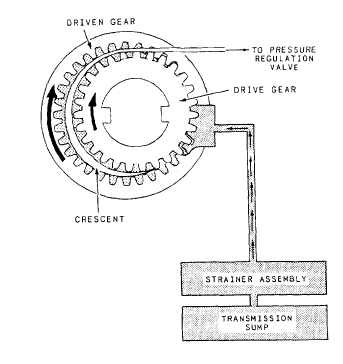A hydraulic system requires a source of clean hydraulic fluid and a pump to pressurize the fluid. The Hydra-Matic Model 400 uses an interred gear type of pump (fig. 7-21) with its oil intake connected to a strainer assembly. The oil is drawn through the strainer from the transmission sump. The pump drive gear is geared or keyed to the driven member of the torque converter; therefore, whenever the engine is in operation, the pump is functioning. As the pump drive gear rotates, it rotates the pump driven gear causing the oil to be lifted from the sump into the oil pump. As the pump gears turn, oil is carried past the crescent section of the pump. Beyond the crescent, the gear teeth begin to come together again forcing the oil out of the pump and into the hydraulic system under pressure. At this point, the oil is delivered to the pressure control system.
Oil pressure is controlled by the pressure regulator valve. As the pressure builds, oil is directed through an orifice to the top of the pressure regulator valve. When the desired pressure is reached, the valve moves down against the spring, thus opening a passage to feed the 'converter. When the converter is tilled, oil returning from it is directed to the transmission cooler in the engine radiator. As the pressure continues to increase, the pressure regulator valve moves to expose a port that directs excess oil to the suction side of the pump. The

Figure 7-21. - Internal gear type of pump assembly.
pressure regulator valve is spring-balanced to maintain line pressure at approximately 70 psi at an idle.
When the transmission selector valve is moved to the D position, the manual valve moves to allow line pressure to be delivered to the forward clutch pack. The oil enters the small area first to provide a smooth initial takeup. The larger area is then filled gradually by oil metered through an orifice to provide the final holding force required
With the forward clutch applied, the mechanical connection for torque transmission between the turbine shaft and the main shaft has been provided. The LO roller clutch assembly becomes effective as a result of the power flow through the compound planetary gearset, and the transmission is in first gear, ready for the vehicle to start moving. As the vehicle begins to accelerate and first gear reduction is no longer required, the transmission automatically shifts to second gear. The vehicle speed signal for the shift is supplied by the transmission governor which is driven by the output shaft. The governor assembly consists of a regulating valve, a pair of primary weights, a pair of secondary weights, the secondary springs, the body, and the driven gear. The governor weights are so arranged that the secondary weights act only on the regulating valve. Because the centrifugal force varies with weight and speed, small changes in output shaft rpm at low speed result in small governor pressure changes. To give even greater change in pressure, the primary weights add force to the secondary weights. As the primary weight moves out at greater vehicle speed, it finally reaches a stop and is no longer effective. From this point on, only the secondary weights and secondary springs are used to apply the force to the governor valve.
Drive oil pressure is fed to the governor. This, in turn, is regulated by the governor valve and gives a governor pressure that is proportional to vehicle speed. To initate the shift from first to second gear, governor oil pressure is directed to the end of the 1-2 shift valve. It acts against the spring pressure holding the valve in the closed position, blocking drive oil. As vehicle speed and governor pressure increase sufficiently to overcome spring force, the 1-2 valve opens, allowing drive oil to flow into the intermediate clutch passage and through an orifice to apply the intermediate sprag effectively which shifts the transmission into second gear. Further increases in vehicle speed and governor pressure will cause the transmission to shift to third gear.
The operation of the 2-3 shift valve is similar to the 1-2 shift valve operation. Springs acting on the valve tend to keep the shift valve closed while governor
Continue Reading